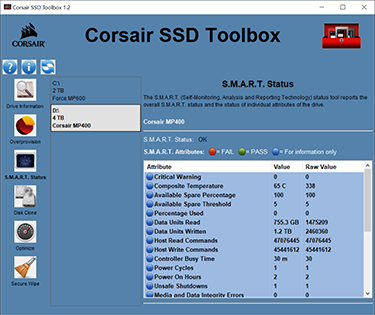Introduction
Most of the recent solid-state storage (SSD) news has centred on hugely fast drives touting the PCIe 4.0 interface available on the latest AMD motherboard chipsets. Offering up to twice the speed of PCIe 3.0 - up to a real-world 7.5GB/s from the usual x4 storage connection - supreme speed sells.
It's now common to see 5GB/s for sequential transfers and handsome IOPs approaching one million. These drives still command a healthy premium over PCIe 3.0 models that continue to sell in droves. It is to this mainstream context that Corsair launches the MP400 NVMe SSD.
Specifications |
||||||
|---|---|---|---|---|---|---|
| Series | Corsair MP400 |
|||||
| Nominal Capacity | 1,000GB |
2,000GB |
4,000GB |
8,000GB |
||
| Controller | Phison PS5012-E12S-32 |
|||||
| NAND | Micron 3D QLC 96-layer (N28) |
|||||
| Interface | PCIe Gen 3 x4, NVMe 1.3 |
|||||
| DRAM | Nanya DDR3L |
|||||
| Sequential Read Speed | 3,480MB/s |
3,480MB/s |
3,480MB/s |
3,480MB/s |
||
| Sequential Write Speed | 1,880MB/s |
3,000MB/s |
3,000MB/s |
3,000MB/s |
||
| Random IOPs (4KB Reads) | 190K IOPS |
380K IOPS |
610K IOPS |
610K IOPS |
||
| Random IOPs (4KB Writes) | 470K IOPS |
560K IOPS |
710K IOPS |
710K IOPS |
||
| Average Active Power | 4.0W |
5.5W |
6.5W |
6.5W |
||
| Idle Power (PS3) | N/A |
|||||
| Sleep Power (PS4) | <5mW |
|||||
| Available Form Factors | M.2 2280 |
|||||
| Endurance | 200TBW |
400TBW |
800TBW |
1,600TBW |
||
| Life Expectancy | 1.8m hours |
|||||
| Warranty | 5 Years |
|||||
| Current Retail Price | £135 |
£265 |
£600 |
£1,380 |
||
There are only so many ways to construct a well-rounded PCIe 3.0 solution which majors on capacity. Corsair pairs up with long-standing partner Phison by employing the eight-channel PS5012-E12S controller for the MP400 series. The 'S' is important as it expands addressable TLC NAND capacity to 4TB and QLC NAND to 8TB. Corsair opts for the latter memory this time around and has 1TB, 2TB, 4TB and 8TB versions in its line-up. E12S can also be paired with 500GB QLC NAND, according to Phison, though MP400 chooses to ignore it.
Corsair mates the controller with 96-layer 3D QLC NAND from Micron known as N28. Specific to our 4TB sample, Corsair uses four 512MB chips on each side meaning there are 11 ICs in total - eight NAND, two buffering DRAM DDR3L chips from Nanya, and the Phison controller. The simple sticker provides no heat-wicking ability. Note, also, Corsair drops the Force Series name for this and subsequent SSDs; this one is known as MP400 alone.
Presented solely in the common M.2 2280 form factor, speeds and feeds are eminently solid for a midrange offering. Corsair says the 4TB drive is capable of 3,480MB/s read and 3,000MB/s write, alongside IOPS that we usually see on premium SSDs. By its very nature, QLC NAND doesn't have the innate endurance of SLC/MLC/TLC memory because more bits are situated in each cell, leading to more wear. Consequently, playing it safe, the 4TB MP400 has an 800TBW rating, compared with 1,800TBW for the 1TB MP600.
Putting it another way, Corsair says you can write the complete drive at least 200 times (0.11 drive writes per day) during the five-year warranty period. We're less concerned with the low-ish endurance as we imagine the MP400 to be used as a fast, infrequent storage repository rather than frequently-accessed boot drive. All that said, it's still worth knowing that Corsair's existing PCIe 3.0 MP510 offers 8.5x the endurance at the same 4TB capacity as this review model.
Speaking to the value narrative, there's neither hardware-based encryption nor a bundled utility such as Acronis for transferring the contents of an existing drive. The latter is a shame as most of the SSD competition include it on their entry-level offerings.
Basic is an apt description for the SSD Toolbox utility. It does what it needs to insofar as firmware updates are straightforward and there's rudimentary reporting on a separate tab that needs refreshing for up-to-date information.
It's huge capacity and relative value that are the MP400's forte. £135 for the 1TB model is generally competitive against other 3GB/s PCIe 3.0 drives from an RRP perspective. Moving up the space scale to where the MP400 shines, other manufacturers using the same combination of Phison controller and QLC NAND in 4TB and 8TB capacities charge similar cash. Do understand the value-for-money metric takes an understandable hit as larger-capacity NAND chips are used in a space-limited M.2 form factor.
The review 4TB capacity was until recently the realm of mechanical storage. Let's now see if Corsair can combine size and decent speed as we fire up the benchmarks.






